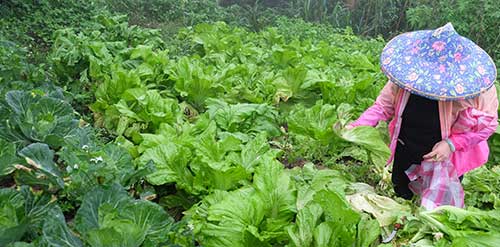Hyundai Motorstudio Senayan Park
Hyundai Motorstudio Senayan Park
Newsroom
The official news from Hyundai Motorstudio Senayan Park and a collection of innovative articles on mobility and sustainability here.
-
Sustainable Agriculture: Definition, Examples, and Its Impact
- Hyundai Motorstudio Senayan Park Senayan Park 2022.06.30
-
Even though sustainable farming techniques have proven successful in increasing yields, unfortunately many farmers are still hesitant to switch to sustainable agriculture. The reason is simple, sustainable agriculture is felt to be a financial burden.
Based on a study by the Sustainable Agriculture Research & Education Program, the reason many farmers are hesitant to adopt sustainable agricultural practices is due to the lack of financial resources, economic incentives, and reliable information.
Therefore, if we want sustainable agriculture to be implemented successfully, then economic incentives are very important. For example, we cannot immediately ask farmers to start sustainable agriculture in order to reduce greenhouse gas emissions. Because, farmers will think this is not profitable for them. Therefore, we need to show more tangible economic benefits.
Definition of sustainable agriculture
Sustainable agriculture can be defined in many ways. However, basically, sustainable agriculture is an effort to maintain farmers, resources, and communities with more environmentally friendly and profitable agricultural practices.
Sustainable agriculture is suitable for implementing and perfecting today's modern agriculture. Call it, organic farming. It is suitable to be applied anywhere, even though the land is limited in the yard. Can be applied to large or small farms, taking advantage of new technologies and updating agricultural practices of the past.
Examples of the application of sustainable agriculture
Next, let's look at some examples of implementing sustainable agriculture to make it easier to understand. As follows:
1. Organic farming
Organic farming is an agricultural method that uses only natural pest control and biological fertilizers to grow crops without the use of chemicals or pesticides. This method optimizes energy and nutrient cycles in agricultural ecosystems.
Research shows that fertilization increases organic carbon in the soil, leading to the release of large amounts of CO2 into the atmosphere. Organic farming practices will help farmers to reduce emissions of nitric oxide and methane from the soil.
That's why this method has a positive impact on the water, surrounding wildlife, soil, atmosphere and farmers in the long term.
2. Crop rotation and polyculture
Crop rotation is an agricultural strategy that involves cultivating different types of crops on the same field in successive seasons. With this method, the chances of plant and vegetable diseases can be reduced. In addition, this practice also reduces the amount of pesticides and chemical fertilizers needed to be environmentally friendly.
3. Renewable alternative energy resources
According to the FAO (Food Association Organization), energy from the agricultural food chain accounts for 35 percent of total GHG (greenhouse gas) emissions. Thus, renewable energy sources, such as solar energy, hydropower, and wind farms, must be used to power agriculture.
In this method, the solar panels are useful for running the pumping and heating systems. Farmers can also use hydroelectric power from a nearby river for various agricultural machines. To find the best alternative resource for their agriculture, farmers are advised to compare energy levels using energy comparison sites that are widely available on websites or online media.
4. Soil tillage management
Tillage is the process of mechanically agitating the soil to prepare it for crop production. Farmers can optimize tillage operations to reduce GHG (greenhouse gas) emissions.
These methods include overturning, digging, and stirring the soil. Reducing tillage will lead to a reduction in fossil fuel consumption. Therefore, this method can reduce GHG (greenhouse gas) emissions in the long term.
5. Agroforestry
Last but not least, an example of sustainable agriculture is using agroforestry techniques. Basically, agroforestry is growing woody perennials on the same land used for agriculture.
Due to maximum land use, this technique is highly productive and sustainable. This method will bring many economic benefits, it is also healthy and beneficial for the environment.
What is the impact of sustainable agriculture?
Sustainable agriculture refers to agriculture that is good for the environment, animals and people. If we respect the earth as a producer of food, water, and plants, then the earth will be in a healthy condition and continue to provide quality resources for future generations.
This type of sustainable agriculture is based on a whole ecosystem approach, not just focusing on specific products like vegetables, meat, eggs, etc. But, on investing in an overall sound system. Including a more sustainable food system sustainability, human and animal welfare, public health, ecological health, and soil health.
Thus, sustainable agriculture does not depend on the addition of synthetic fertilizers or pesticides. Thus, farmers are also less dependent on the availability of chemical fertilizers which consume the operational budget. Sustainable agriculture utilizes plant waste such as dry leaves, stems, stumps, and others, as natural compost. In fact, you can use livestock manure for biological fertilizers that fertilize the soil.
In this case, the cycle of recycling plants and compost will build soil health, clean water systems, and sustainable biodiversity. If sustainable agriculture is applied properly, then the soil condition will always be healthy and ready to reduce the carbon footprint of emissions. This is one of the goals of sustainable development, namely to slow down global climate change.




